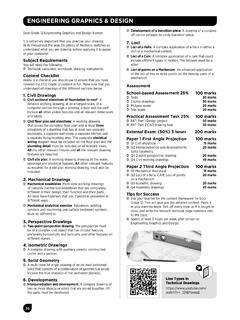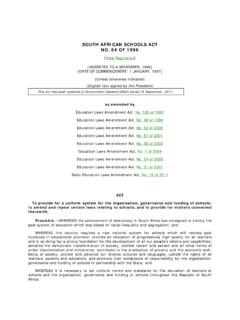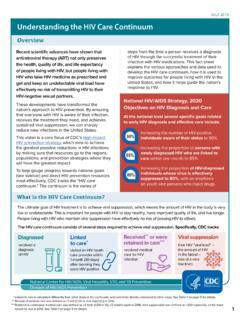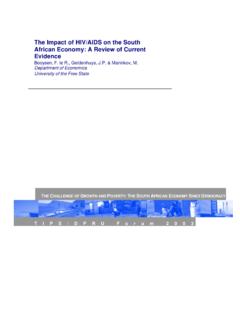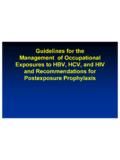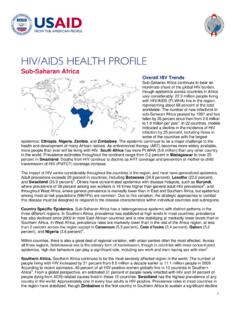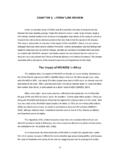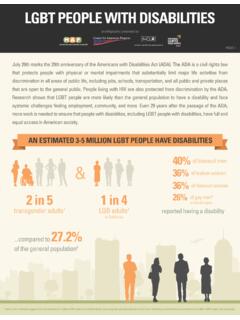Transcription of NATIONAL POLICY ON HIV AND AIDS FOR LEARNERS AND …
1 NATIONAL POLICY ON HIV AND AIDS FOR LEARNERS ANDEDUCATORS IN PUBLIC SCHOOLS AND D STUDENTS ANDEDUCATORS IN FURTHER EDUCATION AND TRAINING INSTITUTIONS(10 AUGUST 1999 VOLUME 410 NUMBER 20372)1. BACKGROUNDHIV and AIDS is one of major challenges to all South Africans. It isestimated that almost 25% of the general population will be HIV positive bythe year 2010. In South Africa HIV is spread mainly through: Sexual contact Breast feeding Mother to childIn keeping with International standards and in accordance with educationlaw and the constitutional guarantees of the right to a basic education,right not to be unfairly discriminated against, the right to life and bodilyintegrity, right to privacy, the right to safe environment and the bestinterests of the PURPOSE / INTENTION OF THIS POLICYTo prevent the spread of HIV demystify HIV & AIDS Allay fears Reduce stigma Instill non-discriminatory attitudesDevelop knowledge, skills.
2 Values and attitudes inorder that they mayadopt and maintain behavior that will protect them from HIV infectionand to support infected and POLICY provides a framework for development of provincial andschools policies and strategic plans for implementation thereofIt further recommends establishment of health advisory committees3. TARGET GROUP LEARNERS and Educators in public schools Students and Educators in further education and traininginstitutions Broader school community Provincial and District officials4. THE SALIENT FEATURES/KEY MESSAGES OF THE PremisesBecause of an increase of infection rates, LEARNERS , students andeducators with HIV & AIDS will increasingly form part of the population ofschools and institutions.
3 Non-discrimination and equality with regard tolearners, students and HIV & AIDS testing and admission of LEARNERS and students and / orthe appointment of Attendance at schools and institutions by LEARNERS or students right to attend any Disclosure of HIV & AID statusLearners and educators are not compelled to disclose their cases where voluntary disclosure of their status has been done, itshould be treated A safe school / institution environmentProvision must be made for all schools and institutions toimplement Universal precautions to eliminate risk of Prevention of HIV transmission during play and Education on HIV & AIDS not to be seen as add on, but part ofthe Duties and responsibilities of LEARNERS , students, educators Refusal to study with or teach a learner or student with HIV andAIDS or to be taught by an educator with HIV and What are its implications in relation to other polices?
4 Revised NATIONAL Curriculum HIV and AIDS issues cut across all learning areas and thereforein the development of learning programmes these issues mustbe Assessment It is important that LEARNERS who are likely to experience barriersto learning and development are identified early, assessed andprovided with learning support. multiple opportunities, adaptivemethods of Education WP 6 Inclusive ed. (barriers and orphans, LEARNERS atrisk) The development of an inclusive education and training systemmust take into account the incidence and impact of the spread ofHIV and AIDS and other infectious Norms and Standards for For the provisioning of all the appropriate equipment toimplement universal precautions to eliminate risk of transmission(first aid kits, rubber gloves) Work Place Skills Should include development programmes that would addressissues on HIV and Whole school evaluation, school development plans (vision,mission)
5 And school improvement plans must also include HIVand AIDS planned strategy to cope with the pandemic. SASAo LEARNERS of compulsory school going age with HIV/AIDmay be granted exemption form attendance in terms ofSection 4(1)o If and when LEARNERS become incapacitated schools andinstitutions should make work available to them for studyat home and should provide support where Constitution of the Republic of South Africa To prevent discrimination, all LEARNERS , students and educatorsshould be educated about fundamental human What are the possible gaps between POLICY and its implications? Insufficient training for educators with regard to HIV and AIDS Insufficient resources available at institutions Insufficient funding to purchase the necessary resources needed toaddress the issues of HIV and AIDS at institutions Inadequate co-ordination of inter and intra-departmental initiativesconcerning HIV and AIDS POLICY should be updated at regular intervals to accommodate theprogress made in the prevention and treatment of HIV and What are the possible questions concerning the POLICY ?
6 Q. In the development of this POLICY , were all the relevantstakeholders part of the process?R. Yes. According to the NEPPA agreement, all the relevantstakeholders were consulted in the formulation of the POLICY .[Department of Justice, Health, Education and Social Services]Q. Is this POLICY limited to LEARNERS , students and educators of Publicschools only?R. The POLICY is available to Independent schools. Therecommendations and suggestions could be used by these Are there Provincial and District strategies in place for themonitoring and support of the HIV and AIDS POLICY ?R. Yes. The NATIONAL Integrated Plan supported by the Departmentsof Health, Social Services and Education addresses the issue ofHIV and AIDS in a co-ordinated manner.
7 Conditional Grant fundinghas been ring fenced to provide resources and teacher trainingto support the implementation of the POLICY . In every province HIVand AIDS co-ordinators have been appointed to monitor andsupport the implementation of the POLICY . The services of aservice provider has also been obtained to assist Schools andSchool Governing Bodies in developing their HIV and AIDS NGOs and other departments also run HIV and AIDS programmesfor schools. What is the nature of the relationship of the Departmentof Education towards these programmes?R. The NATIONAL Integrated Plan supported by the Departments ofHealth, Social Services and Education addresses the issue of HIVand AIDS in a co-ordinated Schools have admitted HIV and AIDS orphans, do these schoolshave additional support programmes for these LEARNERS ?
8 R. Schools can play a huge role in identifying these LEARNERS so thatthey are able to access social Is there a recourse for parents of LEARNERS , who refuse their childto be taught by a teacher, who is infected?R. Parents can not be What does the POLICY say regarding disclosure of HIV status bylearners and teachers?R. LEARNERS and teachers are not compelled to disclose their status,however a holistic programme for life skills and HIV/AIDS education should encourage voluntary disclosure. Unauthoriseddisclosure of HIV/AIDS related information could give rise to Gazette , , 10th August NOTICES NOTICE 1926 OF 1999 DEPARTMENT OF EDUCATION NATIONAL EDUCATION POLICY ACT, 1996 (NO.)
9 27 OF 1996) NATIONAL POLICY ON HIV/AIDS, FOR LEARNERS AND EDUCATORS INPUBLIC SCHOOLS,AND STUDENTS AND EDUCATORS IN FURTHER EDUCATION ANDTRAINING INSTITUTIONS I, Kader Asmal, Minister of Education, after consultation with theCouncil of Education Ministers, hereby publish the NATIONAL POLICY onHIV/AIDS for LEARNERS in public schools, and students and educators infurther education and training institutions, in terms of section 3(4) ofthe NATIONAL Education POLICY Act, 1996 (No. 27 of 1996), as set out in theSchedule. PROFESSOR KADER ASMAL MINISTER OF EDUCATION AUGUST 1999 SCHEDULENATIONAL POLICY ON HIV/AIDS FOR LEARNERS AND EDUCATORS INPUBLIC SCHOOLSAND STUDENTS AND EDUCATORS IN FURTHER EDUCATION ANDTRAINING INSTITUTIONS PREAMBLE Acquired Immune Deficiency Syndrome (AIDS) is a communicable diseasethat is caused by the Human Immunodeficiency Virus (HIV).
10 In South Africa, HIV is spread mainly through sexual contact betweenmen and women. In addition, around one third of babies born to HIV-infectedwomen will be infected at birth or through breast-feeding. The risk oftransmission of the virus from mother to baby is reduced by antiretroviraldrugs. Infection through contact with HIV-infected blood, intravenous drug useand homosexual sex does occur in South Africa, but constitutes a very smallproportion of all infections. Blood transfusions are thoroughly screenedand the chances of infection from transfusion are extremely People do not develop AIDS as soon as they are infected with HIV. Mostexperience a long period of around 5 - 8 years during which they feel welland remain productive members of families and workforces.
